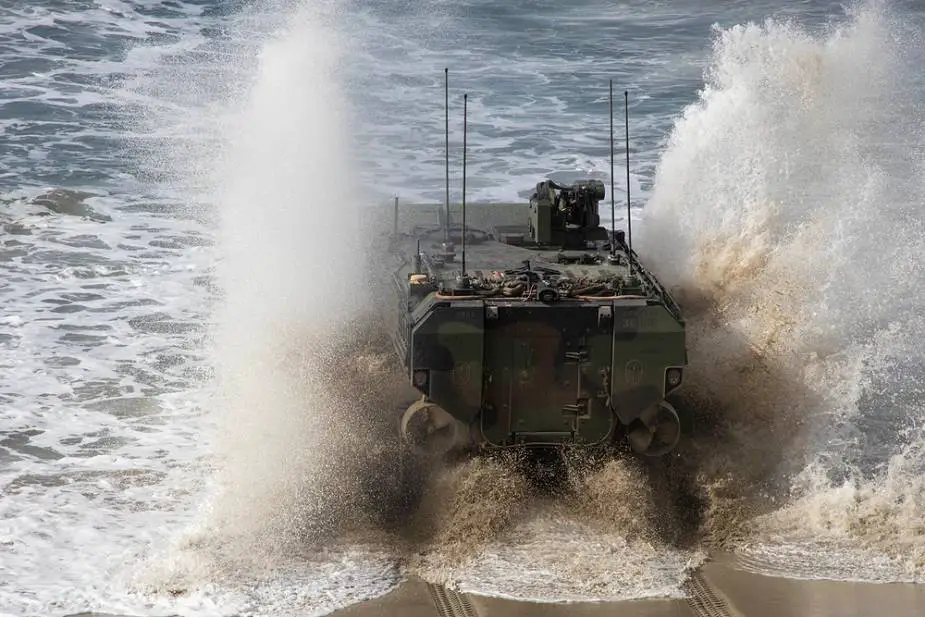Breaking news
US Marines conduct first military exercise with their new ACVs Amphibious Combat Vehicles.
According to pictures released by the United States Department of Defense (DoD), U.S. Marines from 1st Platoon, Charlie Company, 3rd Assault Amphibian Battalion, 1st Marine Division conduct a military exercise with the new Amphibious Combat Vehicles (ACV) during bilateral amphibious assault training as part of exercise Iron Fist 2022 at White Beach, Marine Corps Base Camp Pendleton, California, February 1, 2022.
Follow Army Recognition on Google News at this link

U.S. Marines prepare for waterborne operations in Amphibious Combat Vehicles ACVs during bilateral amphibious assault training as part of exercise Iron Fist 2022 at White Beach, Marine Corps Base Camp Pendleton, California, Feb. 1, 2022. (Picture source U.S. DoD)
Iron Fist is an annual, bilateral, amphibious training exercise that provides realistic, relevant training necessary for effective combined military operations. Iron Fist is conducted at Marine Corps Base Camp Pendleton, Marine Corps Air Ground Combat Center and Marine Air-Ground Task Force Training Command, and associated offshore training areas.
For the edition 2022 of Iron Fist, U.S. Marines with I Marine Expeditionary Force and U.S. Navy sailors with U.S. 3rd Fleet trained alongside Japan Ground Self-Defense Force soldiers during exercise.
In June 2018, the ACV entered Low-Rate Initial Production (LRIP) with BAE Systems selected for the first 30 vehicles to be delivered in fall 2019. In November 2020, the ACV achieved Initial Operational Capability (IOC). The currently planned acquisition objective of 632 ACVs would replace AAVs in Assault Amphibian battalions.
According to our information, this is the first operational deployment of the new Amphibious Combat Vehicles (ACV) that will replace the old Amphibious Assault Vehicle (AAV) which is in service since 1972. What is really interesting in the evolution of the strategy of the US Marines is the change from a tracked vehicle to a wheeled vehicle. The Amphibious Combat Vehicle (ACV) is the U.S. Marines Corps’ next-generation combat vehicle designed to move Marines from ship to shore. The ACV will be the primary means of tactical mobility for the U.S. Marines infantry battalion at sea and ashore.

New Amphibious Combat Vehicle of the U.S. Marine Corps conduct amphibious operation during Iron Fist 2022. (Picture source U.S. DoD)
The ACV will be delivered to the U.S. Marine Corps in four variants including an armored personnel carrier (ACV-C) which can carry three crew members, 13 soldiers and two days of combat equipment and supplies, a Command and Control Variant, a Recovery Variant (ACV-R) and a 30-mm Gun Variant (ACV-30).
The ACV is an 8x8 amphibious armored vehicle designed and manufactured by the company BAE Systems in collaboration with the Italian company Iveco Defence Vehicles. The layout of the ACV consists of three main compartments with the driver at the front left of the hull with the engine on its right, commander and weapon station in the middle, and troops area at the rear. The hull has been designed to provide high levels of protection against both mine and IED attacks without compromising the vehicle’s amphibious performance. In the water, the ACV is propelled in the water at a maximum speed of 11 km/h thanks to two propellers which were situated on either side of the hull at the rear.
The Armored Personnel Carrier (ACV-C) variant can accommodate 13 soldiers. The Marines enter and leave the vehicle through a large hydraulically operated ramp at the rear of the hull, which has an integral door in the center.
The ACV is powered by a six-cylinder diesel engine developing a 690 hp maximum. The vehicle can reach a top road speed of 105 km with a maximum cruising range of 523 km at 89 km/h.



















